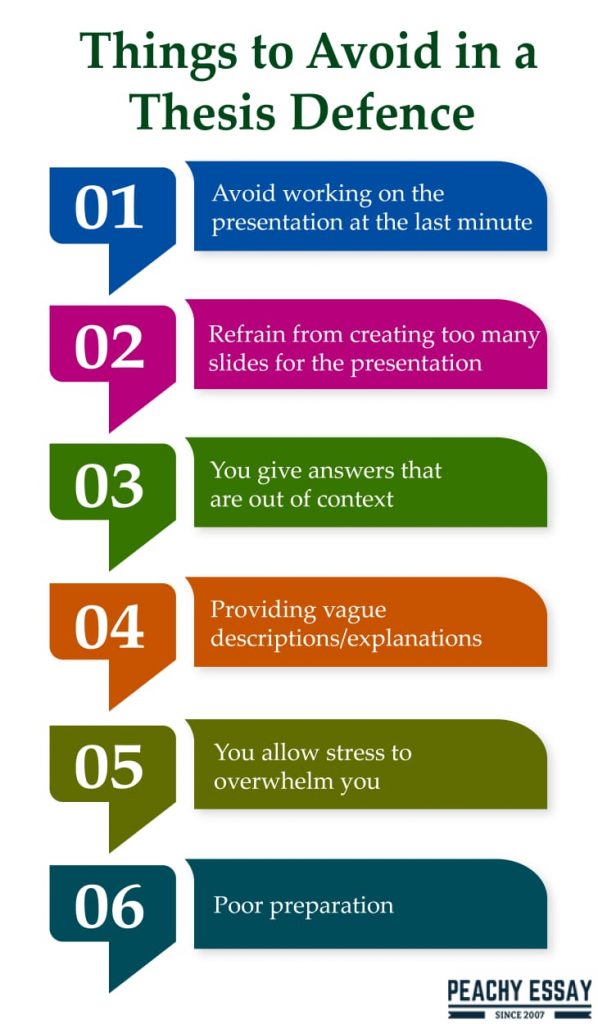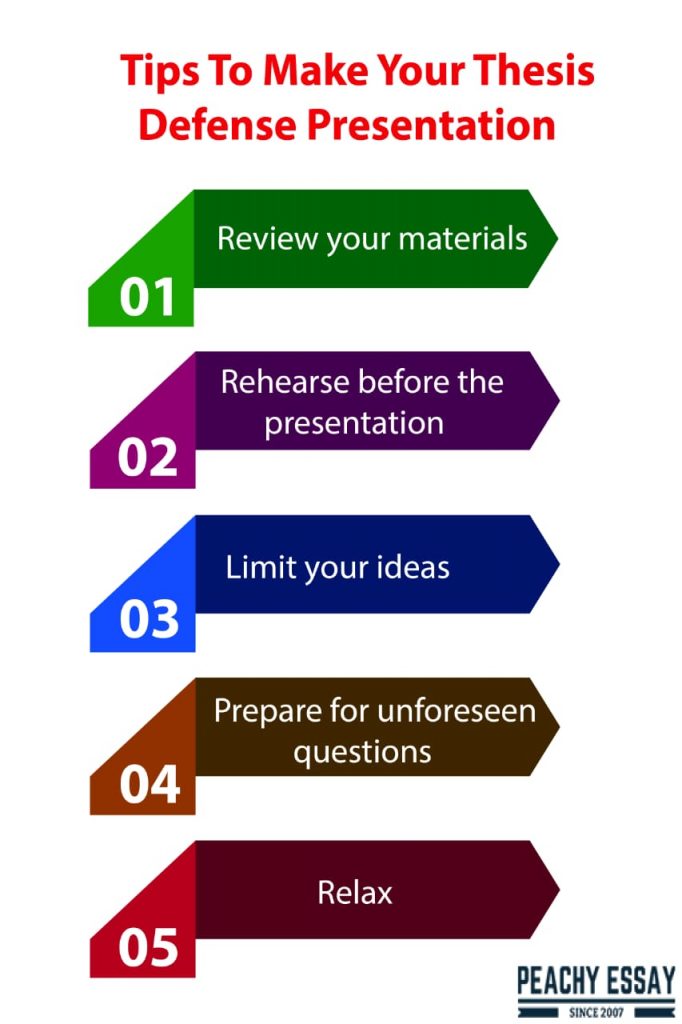The thesis refers to the statement that shows your stand or beliefs according to the research that you carry out. In addition, it shows the direction the essay or report will take. A captivating and clear thesis presentation makes it easier for your targeted audience to listen to your work.
Now that you have the audience’s attention, how do you persuade each person to agree with your thoughts? How do you air your opinions in an organized way? A good thesis defense ensures your data remains organized and the flow of work is clear. However, that should not intimidate you. With the proper presentation and preparation, you can ace it. In this article, you will learn how to defend your thesis in a presentable way.
What Should be Included in a Thesis Defense Presentation?
Your thesis defense presentation should include the main concept of the research, proper structure, and conclusion. Those mentioned above are within the outline you will look at later.
The concept refers to the idea behind the project or the main goal. That is what directs the design of the slides. For example, if you want to solve poor management in salons, your slides should be brightly colored or colorful. In addition, you could use cursive fonts for the subtitles.
The structure shows the flow of the presentation. Use the outline described later on in the article. Ensure that the designs go hand in hand with the concept. Another example is the banking system. Your slides could have images of coins on the edges or in the background. That would work well on the title page. The colors depict the tone you will be using. For the banking system, use warm or dull colors.
Use the same or consistent style for all the slides. In the literature review section, you want to avoid too much text. Bullet points come in handy here. Avoid paragraphs. Short notes will suffice. Use graphics for the methodology. Ensure the graphics go hand in hand with the theme. Infographics and icons are relevant in presentations.
It is important to finish strong. Therefore, the conclusion is to remind the panelists what the thesis is all about and the research questions you were able to answer. If you have any takeaways, they should be here. The conclusions go in the recommendations section.
How do you Introduce a Thesis Defense?
Start by greeting the audience and introducing yourself. Then give the topic of your discussion. Next, justify the topic then give an outline of the presentation. Below is an example of an introduction:
Good morning everybody. My name is Mary Smith and the topic for my discussion today is management in salons. Recent research shows that most small and medium enterprises, including salons, fail to reach their maturity stage because of poor management. That means they do not last up to 5years. For that reason, I am carrying out research to come up with salon software to assist in management. I will divide my work into five parts: the objectives, literature review, methodology, results, and conclusion. I will be happy to answer your questions as soon as I am done with the presentation.
What are the Things that you Should not do in a Thesis Defense?
Here are the things you should avoid doing in a thesis defense.

Avoid working on the presentation at the last minute
I cannot emphasize how important it is to revise your work severally before the presentation date. Preparing the slides late means that you are rushing, and you might therefore miss the main points. There are also chances of repeating the same content or putting so many ideas.
Refrain from creating too many slides for the presentation
Inthiscase, less is more. Too many slides will push you away from the main points. That will also make it harder to present in the short time allocated.
You give answers that are out of context
If you do not know the correct answer, it is okay to admit that rather than provide responses that you cannot reference. After all, the panelists do not expect you to know everything.
Providing vague descriptions/explanations
The thesis committee wants to know what your work is about. Therefore if you are not clear, you discredit yourself.
You allow stress to overwhelm you
That might be a stressful time for most students. To avoid all that tension, sleep enough before the presentation. Otherwise, you will perform poorly regardless of whether you prepared well.
Poor preparation
That makes it challenging to respond to questions or give a proper presentation. Instead, you could listen to other presentations to have a brief overview of what to expect.
How Long Should A Thesis Defense Presentation Be?
For most institutions, the presentation is thirty minutes long. That may vary from one institution to another or according to the requirements of the degree. The defense may therefore go on for as long as two hours. Ph.D. defenses, for example, take ninety minutes. You, therefore, need to talk to your supervisor to know the allocated time.
It is vital to note that the defense is made of two parts:
- Presenting your work. The thesis is like proof of the research you have been carrying out through your entire schooling. It depicts the understanding you have of your major or program. Prior preparation is mandatory.
- You receive questions from your audience. It consists of three people: the external examiner and two people from the thesis committee.
You will have 20 minutes to present your thesis and 10 minutes for the questions in most cases.
A Sample Outline of the Thesis Defense Presentation
A good structure of your work will boost your confidence when presenting. It also makes it easier to remember your argument. Remember to keep the slides brief and precise. The outline below mainly focuses on the slides you will use. Note that moving through each slide will help you have a good flow when giving the oral presentation.
- The objectives/goals of your project take 2 minutes. In this section, your current slide should show the title page, and next is the introduction page.
The title page slide consists of: the title of your project, name, your institution’s name, details of your program/course, and the name of your advisor.
The introduction slide consists of: the topic, which shows the basis of your research, some of the research questions you were able to answer together, why the questions are relevant to the project, and the research objectives.
- The literature review takes 5 minutes. That refers to research that is similar to yours. Start by writing your thesis statement. That is the basis for your results/findings.
Then briefly describe the previous literature and a reason for choosing them. For example, if it is software, one reason could be the number of reviews it has.
You can highlight their weaknesses and knowledge gaps and show how your research overcomes them.
Lastly, illustrate how your research contributes to the field in question. For example, if your research is on salon software, how does your proposed system improve or differ from the existing software in the management of salons.
- The methodology takes 5 minutes. Start by introducing the methodological approach/method. Qualitative and quantitative research methods are examples of methodological approaches. Next, explain the relevance of the method to your research.
Then introduce the instruments/tools for data collection. Examples include questionnaires, observation, surveys, and interviews. If your data is from existing research, you could write the original methods of data collection. In such a situation, you need to reference that work.
Next, discuss the analysis of the data. Of course, that depends on the methods you used. A good example is a statistical analysis.
Then discuss the sampling procedure. If you decide to carry out interviews, how will you choose the interviewees? You can indicate why the sampling method is applicable in the research.
That is the part that validates the information that you acquire. If you use inappropriate tools or techniques, your data will be inaccurate.
- The findings/results take 10 minutes. That part shows your discoveries. Start by presenting the data in graphs, charts, or tables. The pictures reduce the monotony of text and keep the audience interested in the presentation.
Give an analysis of the data you presented. An example is “Majority of my respondents are men between the age of 25 and 35”.
Next, report the major findings of your research. How does it relate to your course/program?
- Your recommendations (5 minutes). Here is where you provide answers to your research questions, the limitations or challenges, and suggestions.
Important Tips To Make Your Thesis Defense Presentation A Success

Review your materials
Regardless of how confident you feel, study all your work several times. Ensure that you know everything about your project. You want to avoid perusing the hard copy when giving the oral presentation. That validates that the work is solely yours and that you have a good understanding of what your project is about.
If you are using gadgets such as a microphone or laptop for the presentation, test them before the due date. Make the necessary adjustments. You do not want to start presenting only to realize that there are malfunctions.
Having the appropriate points will boost your ego.
Rehearse before the presentation
You could ask your friends to listen to your presentation or stand in front of your mirror. If you are a shy person, that will boost your confidence for the actual presentation. Ensure that you time yourself so that you can give a detailed report in a limited time.
Ensure that you state what is relevant. Be careful when preparing your slides because you will keep repeating them during the defense if you write too much.
It is okay if your defense sounds like a script. The important thing is to be precise and brief.
As you prepare, remember to work on your attitude. Avoid thinking of how everything could go wrong because that is the beginning of trouble. Instead, note the points you cannot wait to share.
Limit your ideas
Giving only the necessary or main points will ensure that you are not monotonous and present in the given time frame. However, ensure that what you provide is enough.
Prepare for unforeseen questions
That is why you need to understand your thesis vividly. There are certain aspects you are not sure of; answering questions will be a challenge.
Regardless of how prepared you are, the panel will always have tricky questions for you. They aim to know whether you have done enough research and your level of preparation. Your confidence is crucial here.
Ensure that what you say does not conflict with your written thesis.
Where you do not know the response to a question, avoid giving answers out of context.
Relax
Take a deep breath before you start presenting. When you are nervous, you will rush through the presentation, or you will have a block. Kindly take it slow in the beginning and then pick up your pace once you regain your confidence. Pause whenever you feel the need. That will improve your articulation.
How to Make A Winning Presentation
- Start by introducing yourself as opposed to going directly into the thesis discussion.
- Ensure that your face is towards the panel.
- Avoid reading the slides. To have a good flow, you could skim through the points instead of reading word for word.
- Dress appropriately.
- Try and speak at your normal pace. That will ensure that your audible and that the committee understands what you are saying. In most cases, nervousness is what makes one speak too fast.
- You can be on the right of the screen for a right-handed person, making it easier to reference the slides. Also, that avoids showing the committee your back.
- Maintain eye contact from time to time with the panelists. That shows confidence.
- Observe the reactions of the panelists and react to them. For example, if you share a point and one panelist looks puzzled, that might be your cue to give a better explanation.
In conclusion, remember that you got this. Have confidence in what you know. Avoid areas that you have little knowledge about and focus on the parts you can handle easily.




